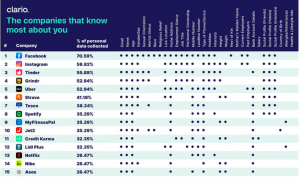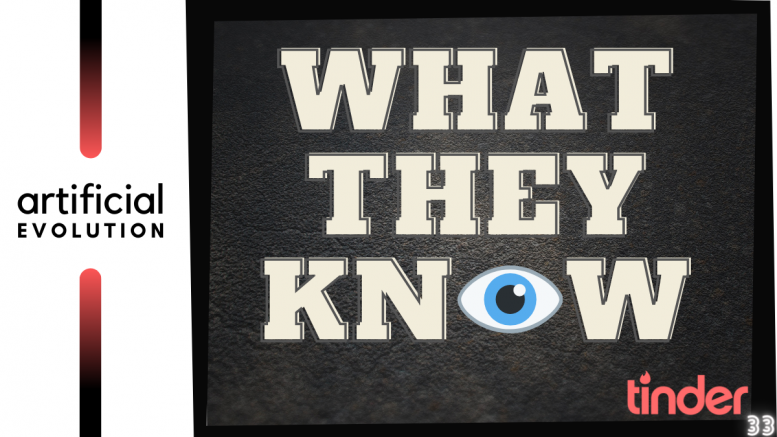Things they know
In our bid to stay connected, our lives have been splashed over the internet like a milkshake gone bad. Free services by large tech corporations collect our personal data in return for said services. Over time, we’ve become used to this arrangement and seem to ignore the sheer level of integration they have had with our online personas.
This series aims to remind us about ‘What they know’
For Part 1 of this series, click here: What they know: Google
For Part 2 of this series, click here: What they know: Facebook
For Part 2 of this series, click here: What they know: Amazon
__________________________________________________________________________________
Author’s Note:
After Google, Facebook and Amazon – I wanted to close this series with something with equal weightage. The obvious choice was Twitter.
And that is exactly why I did NOT choose it.
So let’s swipe right and buckle up.
__________________________________________________________________________________
Tinder.
A digital platform, where like the real world, prettier people get more attention.
A 60 second TL;DR on Tinder
Owned by Match.com, which basically has a monopoly on the dating business, is a service that allows you to meet people based on 3 things. Your display pictures, your bio (some people DO read those) and a proximity range you select (collating potential matches on a specific radius from you). With over 7 million paid subscribers and over 60 million free users across the world., the app has become the undisputed king of ‘relationship apps’.
If you’d like to read an ungodly amount of data and statistics on Tinder, click here.
It’s a lot. So probably click it once you’re done here.
Bro, it’s just a hookup app, isn’t it?
Well, it can be. A lot of people do use it for, how do I put this?… Temporary relationships?
It’s not limited to it though. There are many testimonials of couples in long term relationships, users finding friends that clicked well and even may users who got married to their Tinder matches. But then again, the law of averages makes these things probable.
So, is it just for ‘scoring’?
Like how most MBAs answer everything: It depends
But wait, how does it work?
Back in 2016, Tinder did an exclusive with FastCompany. They showed the journalist just how the compatibility and desirability scores work for individual users.
The CEO, Sean Rad, (REALLY cool name, btw.) stresses that the rating is technically not a measure of attractiveness, but a measure of “desirability,”
To be honest, the explanation seems a bit light on substance:
“It’s not just how many people swipe right on you,” Rad explains. “It’s very complicated. It took us two and a half months just to build the algorithm because a lot of factors go into it.”
They work on the ELO system (originally used in Chess tournaments) – An algorithm that constructs your desirability based on how many ‘highly-swiped users’ right swipe you. Tinder data analyst Chris Dumler calls a “vast voting system.” Every time you swipe right on one person and left on another, you’re fundamentally saying, “This person is more desirable than this other person,” says Dumler. “Every swipe is in a way casting a vote: I find this person more desirable than this person, whatever motivated you to swipe right. It might be because of attractiveness, or it might be because they had a really good profile.”
Okay, so you mentioned just bio and pictures. That’s all they have on me, right?
Not quite. One of the things I’ve learnt during researching companies that hoard, collect, sell or distribute data is that they know how IGNORANT we are. In our bid for instant gratification, we press the ‘ok’ or ‘I agree’ button multiple times without REALLY checking on how much companies are allowed to nest into our private lives.
Tinder isn’t an exception. According to cyber-security firm: F-Secure, Tinder actually knows a whole bunch about you just based on how use the app. Their experts explain:
Spoiler alert: Notice the answer @ 1:30 timestamp.
Okay. Rapid fire time
How much access can Tinder have?
- Name
- Age
- Gender
- Sexual Preference & orientation
- Marital Status
- Live location
- Employment Status
- Job title
- Pet ownership status
- Mobile Number
- Device information
- Hobbies/Interests
- Height
- Bank account details
- Public data from social media profiles (Facebook, Instagram)
P.S. I honestly, did not know THE SHEER SCALE of data collation before I started writing this piece.
So….?
Paid subscribers are one thing. Ad supported free users are another. About 90% of Tinder users are free users. Imagine the amount of detail that can be created around people’s digital persona with a cross referenced bio from Facebook, Google, volunteered information and your app usage couple with your geographic positions are up for sale to the highest bidder.
Does it matter? I’m not on it.
Your friends or family maybe? India is the second largest market for dating apps and with over 81 million singles looking for various definitions of love online, observing this data from a macro point-of-view probably tells you the reality of the situation.
What can I do?
- Make a separate ID for logins (not social plugins)
- Keep in-check what permissions you give the app (including locations)
- Just be careful. Don’t mention personal details. Not going to get you anymore swipes.
__________________________________________________________________________________
End of series.
 Before we go, I wanted to share this infographic from Clario and PCMag to give you a visual perspective on how many permissions top tech companies take to gain access to your digital identity
Before we go, I wanted to share this infographic from Clario and PCMag to give you a visual perspective on how many permissions top tech companies take to gain access to your digital identity
Be curious. Be safe.
See you next week.
The views and opinions published here belong to the author and do not necessarily reflect the views and opinions of the publisher.



Be the first to comment on "What they know: Part 4 – Tinder"